
How to Know When Your Transmission Needs Repair
Imagine driving through Mississauga when suddenly your car hesitates to shift gears, or you feel a hard jolt as you accelerate. Many drivers dismiss these moments as small quirks, but they are often the first warning signs of transmission trouble.
Transmission problems usually start subtly. Catching them early can prevent major breakdowns and costly repairs. In this blog, you’ll learn the signs of transmission issues, what simple checks you can do yourself, and when to bring your car to a repair shop.
What Your Transmission Does and Why Problems Happen
The transmission is responsible for transferring power from the engine to the wheels by selecting the correct gear ratio. Without it, your car cannot move efficiently or safely.
Common reasons a transmission may fail include:
Low or dirty transmission fluid
Worn clutches or bands
Damaged seals and internal leaks
Broken gears or components
Faulty sensors or electronics in modern vehicles
City driving, stop-and-go traffic, towing, and poor maintenance can speed up wear and lead to early signs of failure.
Steps to Identify Transmission Problems
When you suspect your transmission may be failing, use this step-by-step guide to narrow down the problem and act quickly.
Step 1: Pay Attention to Warning Signs
Look out for these common symptoms of transmission trouble:
Delayed, rough, or inconsistent gear shifts
Engine revs without the car accelerating
Unusual noises such as buzzing, whining, or clunking
Puddles of red or brown fluid under the car
Burning smell, especially after longer drives
Warning lights on the dashboard
Shuddering or jerking when accelerating
Trouble engaging certain gears, or total loss of shifting ability
Step 2: Perform Simple At-Home Checks
Even without advanced tools, you can get an idea of what might be wrong. Here’s what to do:
Check the transmission fluid if your car has a dipstick. Healthy fluid is bright red and doesn’t smell burnt.
Use a code scanner to detect transmission-related fault codes if you have one available.
Pay close attention on a careful test drive. Does the problem get worse when the car is warm, under acceleration, or going uphill?
Step 3: Decide Whether to Repair, Rebuild, or Replace
Depending on the issue, your next step could be:
Repairing smaller faults like leaks, sensors, or solenoids
Rebuilding the transmission if several internal parts are worn
Replacing the transmission entirely if it has suffered catastrophic failure or is too old to save
A professional mechanic can run full diagnostics and guide you toward the most cost-effective solution.
Step 4: Get a Professional Inspection
If symptoms persist, the safest move is to have your car inspected by a trusted auto repair shop. Certified technicians can confirm the problem and recommend the right solution before further damage occurs.
Frequently Asked Questions
How many kilometers before a transmission typically fails?
Many transmissions last between 150,000 and 250,000 kilometers, but lifespan depends heavily on driving habits and maintenance.
Can low transmission fluid cause slipping?
Yes. Low fluid reduces hydraulic pressure, which makes gears slip and can quickly lead to serious internal damage.
Is it safe to keep driving with a bad transmission?
It is not recommended. Continuing to drive can lead to complete failure, damage to other components, and higher repair costs.
How much does a transmission rebuild cost in Ontario?
The cost depends on your vehicle and the extent of damage. Partial repairs may be a few thousand dollars, while full rebuilds or replacements can be significantly more.
What is the difference between transmission repair and rebuild?
A repair fixes specific faulty parts, while a rebuild involves disassembling the transmission and replacing multiple worn components to restore it closer to original condition.
Conclusion
Your car’s transmission is essential for safe and reliable driving. When you notice issues such as slipping gears, leaks, or rough shifting, don’t ignore them. By spotting the signs early and getting professional help, you can avoid larger, more expensive problems and keep your car performing at its best.